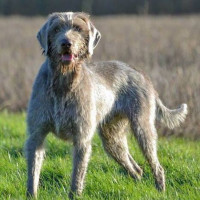Appearance of the Great Wirehaired Gryfenees
|
| The Great Wirehaired Gryfenees is generally a rather large dog, giving a noble, elegant impression. There's a big difference in size between the two parent breeds, and the hybrid usually falls somewhere in between, smaller than the Pyrenean Mountain Dog, but larger than the medium-sized Wirehaired Gryfenees Korthals. They have a medium-width skull in proportion to their body, a medium-length, slightly square muzzle and eyes that can be elliptical or almond-shaped and can be any shade of yellow or brown and their rounded V-shape the ears can be carried high or low on the skull, depending on the dog's preferred parent breed. This crossbreed has a double coat, the undercoat being fine and thick with a woolly or downy texture with a medium-long, stiff coat or a thick layer of long, stiff hair covering it. |
Temperament of the Great Wirehaired Gryfenees
|
| The Pyrenean Mountain Dog is a strong-willed, independent animal that can sometimes be difficult to train, but has excellent protective instincts, while the Wirehaired Gryfenees Korthals is very people-oriented and fairly easy to train, but has an extremely gentle disposition. Both parent breeds can be reserved for strangers, so this hybrid needs to be well socialized when they're young to prevent caution turning into shyness or aggression. Interactions between dogs and children should always be monitored, however, Great Wirehaired Gryfenees should get on well with most children, although they can be a little too energetic for the very young, especially when the dogs are still in their teens. Although they are generally gentle and easy-going with their own families, some Great Wirehaired Gryfenees can inherit the guarding tendencies of the Pyrenean Mountain Dog and become somewhat overprotective of children or other animals in their herd. |
Needs and activities of the Great Wirehaired Gryfenees
|
| Although the Great Wirehaired Gryfenees is known to be an extremely energetic dog, Pyrenean Mountain Dogs tend to be a little more easygoing, the combination of the two creating a dog that can be an enthusiastic exercise partner when needed, but doesn't require as much vigorous exercise a day to keep fit as the purebred Great Wirehaired Gryfenees. As a general rule, this crossbreed will settle for at least an hour's activity a day, which is usually enough, although an hour and a half or more is probably appreciated. These dogs are generally a little too noisy and energetic to be satisfied living in an apartment, and are much happier in a home with plenty of space and a yard. |
Maintenance of the Great Wirehaired Gryfenees
|
| Grooming requirements for this dog are simpler than they seem, even though they inherit the thicker double coat of the Pyrenean Mountain Dogs. Both parent breeds have coats that are naturally resistant to water and dirt, so this dog generally only needs to bathe infrequently. While it's possible to get a Great Wirehaired Gryfenees that has the lower coat of the Wirehaired Pointing Griffon Korthals, you're just as likely to get the heavily shedding Pyrenean coat. Their ears hang down a little, which makes them a little more prone to ear infections, so their ears need to be inspected and cleaned several times a month to prevent problems arising. |









 English (United Kingdom)
English (United Kingdom)